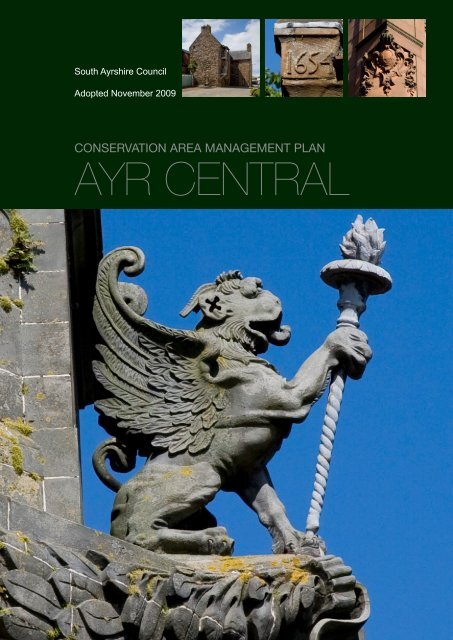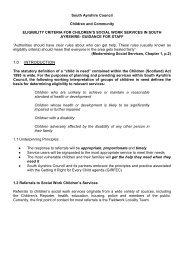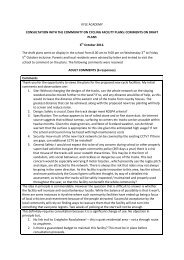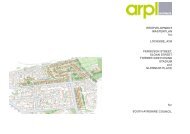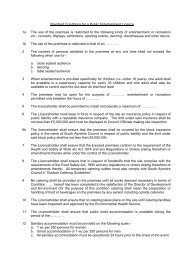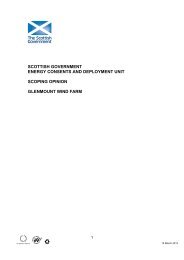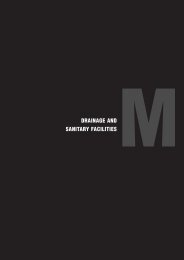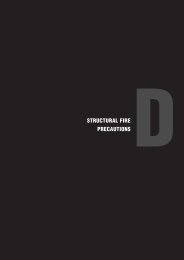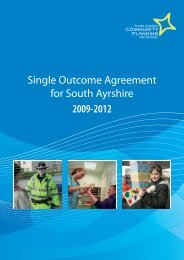Ayr Central Conservation Area Management Plan - South Ayrshire ...
Ayr Central Conservation Area Management Plan - South Ayrshire ...
Ayr Central Conservation Area Management Plan - South Ayrshire ...
You also want an ePaper? Increase the reach of your titles
YUMPU automatically turns print PDFs into web optimized ePapers that Google loves.
<strong>South</strong> <strong>Ayr</strong>shire Council<br />
Adopted November 2009<br />
CONSERVATION AREA MANAGEMENT PLAN<br />
AYR CENTRAL
AYR CENTRAL CONSERVATION AREA MANAGEMENT PLAN<br />
ADOPTED NOVEMBER 2009<br />
Prepared by Nick Haynes, Historic Buildings Consultant, for <strong>South</strong> <strong>Ayr</strong>shire Council<br />
Department of Development, Safety & Regulation<br />
<strong>South</strong> <strong>Ayr</strong>shire Council<br />
Burns House<br />
Burns Statue Square<br />
AYR<br />
KA7 1UT<br />
www.south-ayrshire.gov.uk<br />
The production of this document is part-funded by the Heritage Lottery Fund under the<br />
Townscape Heritage Initiative Stage 2 Development Award for <strong>Ayr</strong>.<br />
© Text: <strong>South</strong> <strong>Ayr</strong>shire Council.<br />
© Mapping: Crown copyright. All mapping data is licensed to <strong>South</strong> <strong>Ayr</strong>shire Council from<br />
Ordnance Survey with the permission of the Controller of Her Majesty’s Stationery Office.<br />
All rights reserved. Licence number 100020765.<br />
© Images: copyright of Nick Haynes unless otherwise credited.<br />
Front cover images:<br />
1. Detail of griffin, Town Buildings, New Bridge Street.<br />
2. Loudoun Hall, Boat Vennel.<br />
3. Date stone, Old Parish Church.<br />
4. Detail of carving at 116 high Street.<br />
Back cover image:<br />
1. Street sign and post box, Bruce Crescent.<br />
1
<strong>Ayr</strong> <strong>Central</strong> <strong>Conservation</strong> <strong>Area</strong> Draft <strong>Management</strong> <strong>Plan</strong><br />
CONTENTS<br />
1 INTRODUCTION<br />
1.1 Purpose of the <strong>Management</strong> <strong>Plan</strong> ……………………………………………<br />
1.2 Format of the <strong>Management</strong> <strong>Plan</strong> ……………………………………………..<br />
1.3 Relationship with planning and other objectives ………………………….<br />
1.4 Status ……………………………………………………………………..............<br />
1.5 Stakeholders ……………………………………………………………………...<br />
1.6 Disability equality ………………………………………………………………..<br />
1.7 Period of operation ……………………………………………………..............<br />
1.8 <strong>Ayr</strong> <strong>Central</strong> <strong>Conservation</strong> <strong>Area</strong> Character Appraisal ……………………...<br />
2 PLANNING CONTEXT<br />
2.1 General: legislation, policy, and guidance …………………………………..<br />
2.2 Implications of conservation area designation …………………………….<br />
2.3 Designation of <strong>Ayr</strong> <strong>Central</strong> <strong>Conservation</strong> <strong>Area</strong> …………………………….<br />
2.4 Boundaries ………………………………………………………………………..<br />
2.5 Summary of other statutory designations in the conservation area …...<br />
3 ORGANISATIONAL MEASURES<br />
3.1 Background ……………………………………………………………………….<br />
3.2 <strong>Ayr</strong> Renaissance Company …………………………………..........................<br />
3.3 <strong>South</strong> <strong>Ayr</strong>shire Council: Knowledge and Skills …………………………….<br />
3.4 <strong>South</strong> <strong>Ayr</strong>shire Council: Streetscape Working Group and Public Realm<br />
Strategy ……………………………………………………………………………<br />
3.5 <strong>South</strong> <strong>Ayr</strong>shire Council: Council Properties ………………………………..<br />
3.6 Portfolio Carrier ………………………………………………………………….<br />
3.7 <strong>Ayr</strong> <strong>Central</strong> <strong>Conservation</strong> <strong>Area</strong> Advisory Group ……………………………<br />
4 PLANNING MEASURES<br />
4.1 Local <strong>Plan</strong> policies ………………………………………………………………<br />
4.2 <strong>Conservation</strong> area boundary amendments …………………………………<br />
4.3 Article 4 Directions ………………………………………………………………<br />
4.4 Control of Advertisements ……………………………………………………..<br />
4.5 Protection of mediaeval rigs …………………………………………………..<br />
4.6 Enforcement ……………………………………………………………………...<br />
4.7 Use of statutory powers: repairs notices, urgent works notices,<br />
dangerous buildings notices and compulsory purchase orders ………..<br />
4.8 Tree Preservation Orders ………………………………………………………<br />
4.9 Supplementary <strong>Plan</strong>ning Policy Guidance ………………………………….<br />
4.10 Site-specific development briefs ……………………………………………..<br />
PAGE<br />
4<br />
4<br />
5<br />
5<br />
5<br />
5<br />
5<br />
5<br />
6<br />
8<br />
8<br />
8<br />
9<br />
9<br />
9<br />
10<br />
10<br />
10<br />
11<br />
12<br />
12<br />
12<br />
13<br />
14<br />
14<br />
14<br />
16<br />
17<br />
17<br />
17<br />
18<br />
18<br />
19<br />
19<br />
2
<strong>Ayr</strong> <strong>Central</strong> <strong>Conservation</strong> <strong>Area</strong> Draft <strong>Management</strong> <strong>Plan</strong><br />
PAGE<br />
5 RESOURCE MEASURES<br />
5.1 <strong>Ayr</strong> Renaissance Company: <strong>Ayr</strong> Renaissance Project …………………...<br />
5.2 Heritage Lottery Fund: Townscape Heritage Initiative …………………...<br />
5.3 Historic Scotland: <strong>Conservation</strong> <strong>Area</strong> Regeneration Scheme ………….<br />
5.4 Historic Scotland: Building Repair Grants ………………………………….<br />
5.5 <strong>South</strong> <strong>Ayr</strong>shire Council: Private Sector Housing Grant Scheme ……….<br />
5.6 <strong>South</strong> <strong>Ayr</strong>shire Council: <strong>Management</strong> <strong>Plan</strong> Actions ………………………<br />
20<br />
20<br />
20<br />
21<br />
22<br />
22<br />
23<br />
6 PROJECT MEASURES<br />
6.1 Tackling building maintenance ……………………………………………….<br />
6.2 Training and education initiatives ……………………………………………<br />
6.3 Interpretation and awareness initiatives ……………………………………<br />
6.4 Repair of historic buildings ……………………………………………………<br />
6.5 Public realm improvements at <strong>South</strong> Harbour Street ……………………<br />
6.6 Public realm improvements to the riverside walk ………………………..<br />
6.7 Public realm improvements at Sandgate, High Street and Newmarket<br />
Street ………………………………………………………………………………<br />
6.8 Replacement of riverfront buildings behind 12-16 and 26-48 High<br />
Street ………………………………………………………………………………<br />
6.9 Re-design of Burns Statue Square …………………………………………..<br />
6.10 Redevelopment of Boswell Park area ……………………………………….<br />
24<br />
24<br />
25<br />
25<br />
26<br />
26<br />
27<br />
27<br />
27<br />
28<br />
28<br />
7 IMPLEMENTATION<br />
7.1 Programme of measures ………………………………………………………<br />
7.2 Consultation and long-term community engagement ……………………<br />
7.3 Adoption …………………………………………………………………………..<br />
7.4 Monitoring and review ………………………………………………………….<br />
29<br />
29<br />
32<br />
32<br />
32<br />
APPENDIX A: <strong>South</strong> <strong>Ayr</strong>shire Local <strong>Plan</strong> design guidance panels……………...<br />
APPENDIX B: Summary of <strong>South</strong> <strong>Ayr</strong>shire Local <strong>Plan</strong> policies relevant to <strong>Ayr</strong><br />
<strong>Central</strong> <strong>Conservation</strong> <strong>Area</strong> …………………………………………..<br />
33<br />
36<br />
3
<strong>Ayr</strong> <strong>Central</strong> <strong>Conservation</strong> <strong>Area</strong> Draft <strong>Management</strong> <strong>Plan</strong><br />
This product includes mapping data licensed from Ordnance Survey with the permission of the Controller of Her Majesty’s<br />
Stationery Office. © Crown copyright and/or database right 2008. All rights reserved. Licence number 100020765.<br />
<strong>Ayr</strong> <strong>Central</strong> <strong>Conservation</strong> <strong>Area</strong> Boundary, August 2009.<br />
1<br />
INTRODUCTION<br />
1.1<br />
The Purpose of the <strong>Management</strong> <strong>Plan</strong><br />
The <strong>Ayr</strong> <strong>Central</strong> <strong>Conservation</strong> <strong>Area</strong> <strong>Management</strong> <strong>Plan</strong> is intended to establish a<br />
planning and management framework for maintaining the special character of<br />
the area and for taking forward enhancement proposals within the constraints of<br />
available resources. The <strong>Management</strong> <strong>Plan</strong> draws on the <strong>Ayr</strong> <strong>Central</strong><br />
<strong>Conservation</strong> <strong>Area</strong> Character Appraisal of October 2008, which identified the key<br />
elements that contribute to the special historic and architectural character of the<br />
area and set out a number of potential opportunities for preservation and<br />
enhancement.<br />
‘When effectively managed, conservation areas can anchor thriving<br />
communities, sustain cultural heritage, generate wealth and prosperity and<br />
add to quality of life. To realise this potential many of them need to continue<br />
to adapt and develop in response to the modern-day needs and aspirations of<br />
living and working communities. This means accommodating physical, social<br />
and economic change for the better. Physical change in conservation areas<br />
does not necessarily need to replicate its surroundings. The challenge is to<br />
ensure that all new development respects, enhances and has a positive<br />
impact on the area.’<br />
Scottish Government, <strong>Plan</strong>ning Advice Note 71: <strong>Conservation</strong> <strong>Area</strong><br />
<strong>Management</strong><br />
4
<strong>Ayr</strong> <strong>Central</strong> <strong>Conservation</strong> <strong>Area</strong> Draft <strong>Management</strong> <strong>Plan</strong><br />
1.2<br />
Format of the <strong>Management</strong> <strong>Plan</strong><br />
The <strong>Management</strong> <strong>Plan</strong> sets out the planning context of <strong>Ayr</strong> <strong>Central</strong> <strong>Conservation</strong><br />
<strong>Area</strong> and proposes a framework to address the issues raised by the Character<br />
Appraisal under the following types of action:<br />
• Organisational measures<br />
• <strong>Plan</strong>ning measures<br />
• Economic measures<br />
• Project measures<br />
Finally the implementation programme and formal adoption process are<br />
described.<br />
1.3<br />
Relationship with planning and other objectives<br />
The objectives and measures in the <strong>Management</strong> <strong>Plan</strong> include several that<br />
address planning matters and development issues. Objectives and actions that<br />
reflect or relate to other policy areas or functions of the local authority are also<br />
included, and are consistent with the ambitions of the <strong>Ayr</strong> Renaissance Strategy<br />
and the Single Outcome Agreement 2008-2009 (LO13) between <strong>South</strong> <strong>Ayr</strong>shire<br />
Council and the Scottish Government. <strong>Plan</strong>ning policies in the <strong>Management</strong><br />
<strong>Plan</strong> are consistent with the statutory planning position set out in the Council’s<br />
Local <strong>Plan</strong> and the <strong>Ayr</strong>shire Joint Structure <strong>Plan</strong>.<br />
1.4<br />
Status of the <strong>Management</strong> <strong>Plan</strong><br />
The <strong>Management</strong> <strong>Plan</strong> will have the status of supplementary planning guidance.<br />
Where the <strong>Management</strong> <strong>Plan</strong> addresses planning issues, it will be a material<br />
consideration in determining proposals. The detailed objectives and actions set<br />
out in the <strong>Management</strong> <strong>Plan</strong> are intended to complement the more general<br />
policy objectives of the <strong>South</strong> <strong>Ayr</strong>shire Local <strong>Plan</strong> and should be used in<br />
conjunction with it. The new <strong>South</strong> <strong>Ayr</strong>shire Local <strong>Plan</strong> (from 2012) will refer to<br />
this <strong>Conservation</strong> <strong>Area</strong> <strong>Management</strong> <strong>Plan</strong> and other supplementary planning<br />
guidance relating to built heritage conservation issues.<br />
1.5<br />
Stakeholders<br />
Effective implementation of the <strong>Management</strong> <strong>Plan</strong> will depend on partnership<br />
between the Local Authority and a wide range of stakeholders including other<br />
public agencies, the private sector and the local community to maximise the coordination<br />
of policy and action.<br />
1.6<br />
Disability Equality<br />
<strong>South</strong> <strong>Ayr</strong>shire Council’s Disability Equality Scheme will inform the<br />
implementation of the <strong>Management</strong> <strong>Plan</strong>. In particular the Council will seek to<br />
involve disability groups and organisations in the development of measures set<br />
out in the <strong>Plan</strong>, and will promote appropriate access improvements to the<br />
historic built environment.<br />
1.7<br />
Period of operation<br />
Subject to review and revision, the <strong>Management</strong> <strong>Plan</strong> will operate from August<br />
2009 to July 2019.<br />
5
<strong>Ayr</strong> <strong>Central</strong> <strong>Conservation</strong> <strong>Area</strong> Draft <strong>Management</strong> <strong>Plan</strong><br />
1.8<br />
<strong>Ayr</strong> <strong>Central</strong> <strong>Conservation</strong> <strong>Area</strong> Character Appraisal<br />
The <strong>Ayr</strong> <strong>Central</strong> <strong>Conservation</strong> <strong>Area</strong> Character Appraisal details the key<br />
elements that contribute to the special historic and architectural character of<br />
the area, and sets out opportunities for preservation and enhancement. Key<br />
characteristics include:<br />
• The strategic location of the town at the mouth of the River <strong>Ayr</strong> where it<br />
meets the Firth of Clyde.<br />
• Foundation as a Royal Burgh by William the Lion in 1205.<br />
• The continued existence of large parts of the early mediaeval layout at<br />
the heart of the town.<br />
• High levels of archaeological potential, both underground and in<br />
standing buildings.<br />
• Structures and planned layouts of historic or architectural interest<br />
dating from most key periods of development in the town.<br />
• The remains of a major Cromwellian citadel, which continue to exert<br />
influence over the layout of the town.<br />
• The ‘set piece’ Town Buildings with their landmark steeple.<br />
• Widespread survival of traditional materials such as stone, slate, and<br />
timber.<br />
• Predominantly residential, commercial and civic land use.<br />
• Public open spaces of historic, natural heritage, recreational and<br />
amenity value.<br />
• Association with important historical events and figures such as William<br />
Wallace, Robert Bruce, and Robert Burns.<br />
• A busy shopping centre, popular with residents, tourists and seaside<br />
visitors alike.<br />
6
<strong>Ayr</strong> <strong>Central</strong> <strong>Conservation</strong> <strong>Area</strong> Draft <strong>Management</strong> <strong>Plan</strong><br />
Summary of <strong>Management</strong> <strong>Plan</strong> responses to principal Character Appraisal<br />
issues<br />
<strong>Conservation</strong> <strong>Area</strong> Character Appraisal issues<br />
Protection of the character of the conservation area<br />
including historic environment assets (scheduled<br />
monuments, archaeological sites, listed buildings,<br />
buildings of character, historic street patterns, historic<br />
public realm features and surfaces, open spaces, parks<br />
and gardens) and views to/from the area.<br />
Bring forward proposal for conservation area boundary<br />
amendments.<br />
<strong>Management</strong><br />
<strong>Plan</strong> Measure<br />
<strong>Plan</strong>ning 1<br />
<strong>Plan</strong>ning 2<br />
Establish Townscape Heritage Initiative. Organisational 1<br />
Resource 2<br />
Project 4<br />
Encourage better general maintenance of buildings. Project 1<br />
Update Supplementary <strong>Plan</strong>ning Guidance. <strong>Plan</strong>ning 9<br />
Produce householder guidance on stone repairs and <strong>Plan</strong>ning 9<br />
painting of façades.<br />
Development briefs for sensitive sites. <strong>Plan</strong>ning 10<br />
Establish co-ordination group for public realm works. Organisational 3<br />
Bring forward policy for protection of the mediaeval rigs. <strong>Plan</strong>ning 5<br />
Bring forward proposals for raising Project 3<br />
awareness/interpretation/education/community<br />
engagement.<br />
Implement public realm improvements to <strong>South</strong> Harbour Project 5<br />
Street.<br />
Implement public realm improvements to riverside Project 6<br />
walkway.<br />
Replacement of riverfront buildings behind 12-16 and 26- Project 8<br />
48 High Street.<br />
Re-design of Burns Statue Square. Project 9<br />
Redevelopment of Boswell Park area. Project 10<br />
Replacement of public realm surfaces in the Sandgate, Project 7<br />
High Street and Newmarket Street with appropriate high<br />
quality natural materials.<br />
Encourage reinstatement of iron railings. <strong>Plan</strong>ning 9<br />
7
<strong>Ayr</strong> <strong>Central</strong> <strong>Conservation</strong> <strong>Area</strong> Draft <strong>Management</strong> <strong>Plan</strong><br />
2<br />
2.1<br />
PLANNING CONTEXT<br />
General: legislation, policy, and guidance<br />
Legislation and Statutory Instruments<br />
<strong>Plan</strong>ning (Listed Buildings & <strong>Conservation</strong> <strong>Area</strong>s)(Scotland) Act 1997.<br />
Town & Country <strong>Plan</strong>ning (Scotland) Act 1997.<br />
The <strong>Plan</strong>ning etc. (Scotland) Act 2006.<br />
Town and Country <strong>Plan</strong>ning (General Permitted Development) (Scotland) Order<br />
1992 (and subsequent amendments).<br />
Policy and guidance<br />
Approved <strong>Ayr</strong>shire Joint Structure <strong>Plan</strong> 2007-2012 (2007).<br />
Adopted <strong>South</strong> <strong>Ayr</strong>shire Local <strong>Plan</strong> 2007-2012 (2007).<br />
The Scottish Ministers, Memorandum of Guidance on Listed Buildings and<br />
<strong>Conservation</strong> <strong>Area</strong>s (1998). Due to be replaced in 2009.<br />
Historic Scotland, Scottish Historic Environment Policy (SHEP) (2008).<br />
Scottish Government, Scottish <strong>Plan</strong>ning Policy 23 (<strong>Plan</strong>ning and the Historic<br />
Environment) (2008). Due to be consolidated into Part Three of a single Scottish<br />
<strong>Plan</strong>ning Policy document in 2009.<br />
Scottish Executive, A Policy on Architecture for Scotland (2001).<br />
Scottish Executive, Designing Places – A Policy Statement for Scotland (2001).<br />
<strong>South</strong> <strong>Ayr</strong>shire Council, Supplementary <strong>Plan</strong>ning Policy Guidance Series<br />
(various dates).<br />
2.2<br />
The Implications of <strong>Conservation</strong> <strong>Area</strong> Designation<br />
<strong>Conservation</strong> areas are ‘areas of special architectural or historic interest, the<br />
character of which it is desirable to preserve or enhance’, designated by<br />
planning authorities as required by Section 61 of the <strong>Plan</strong>ning (Listed Buildings<br />
& <strong>Conservation</strong> <strong>Area</strong>s)(Scotland) Act 1997. <strong>South</strong> <strong>Ayr</strong>shire Council currently has<br />
21 designated conservation areas, varying in character from the urban centres<br />
and residential suburbs to rural villages<br />
The designation places a duty on the planning authority to:<br />
• Review designations ‘from time to time’ and to ensure the preservation<br />
and enhancement of the conservation area (through such measures as<br />
conservation area appraisals, grant schemes or enhancement<br />
proposals);<br />
• Pay special attention to the desirability of preserving or enhancing the<br />
character or appearance of that area in exercising its statutory planning<br />
function.<br />
Other measures affecting conservation areas include:<br />
• Extra publicity must be given to planning applications affecting<br />
conservation areas. This is usually achieved through the use of<br />
advertising in the local newspaper;<br />
• <strong>Conservation</strong> <strong>Area</strong> Consent is required for the demolition of any unlisted<br />
building in a conservation area, subject to minor exceptions, and the<br />
local authority or the Scottish Ministers may take enforcement action or<br />
seek criminal prosecution if consent is not obtained;<br />
• Requirement for planning permission for certain works including small<br />
house extensions and outbuildings, roof alterations, stone cleaning or<br />
painting of the exterior, cladding, provision of hard surfaces, and<br />
satellite dishes.<br />
8
<strong>Ayr</strong> <strong>Central</strong> <strong>Conservation</strong> <strong>Area</strong> Draft <strong>Management</strong> <strong>Plan</strong><br />
• Written notice must be given to the Council before works are carried out<br />
to any tree in the area, subject to minor exceptions;<br />
• The Council or the Scottish Ministers may be able to take steps to<br />
ensure that a building in a conservation area is kept in good repair<br />
through the use of Urgent Works Notices;<br />
• Powers exist for local authorities, Historic Scotland or the Heritage<br />
Lottery Fund to provide financial grant schemes to assist with the<br />
repair of buildings in conservation areas.<br />
Further specific controls, known as ‘Article 4’ and ‘Control of Advertisements’<br />
Directions, extend the requirement for planning permission for certain types of<br />
work in <strong>Ayr</strong> <strong>Central</strong> <strong>Conservation</strong> <strong>Area</strong>. Details of the Article 4 and Control of<br />
Advertisements Directions are set out in sections 4.3 and 4.4 below.<br />
Where sites/monuments are scheduled or buildings are listed in the<br />
conservation area, normal Scheduled Monument Consent or Listed Building<br />
Consent for works is required.<br />
2.3<br />
Designation of <strong>Ayr</strong> <strong>Central</strong> <strong>Conservation</strong> <strong>Area</strong><br />
The <strong>Ayr</strong> <strong>Central</strong> <strong>Conservation</strong> <strong>Area</strong> was originally designated in 1969. The<br />
boundaries were revised in 1976 and 1980. Article 4 Directions were approved<br />
on 22 March 1977 and revisions approved on 11 February 1982. A Control of<br />
Advertisements Direction was approved on 27 April 1983. The conservation<br />
area was classified as ‘outstanding’ for the purposes of grant-aid by the<br />
Historic Buildings Council for Scotland (former advisory body to the Secretary<br />
of State for Scotland and subsequently the Scottish Ministers) in 1978.<br />
2.4<br />
Boundaries<br />
The current boundary of the conservation area (section 1 map) contains the<br />
medieval core of the town, the Citadel, and the villa areas as far south as Miller<br />
Road; there is a substantial ‘exclusion zone’ within the area that takes account<br />
of the modern developments and gap sites at the back of the High Street<br />
around Carrick Street, Boswell Park and Dalblair Road. Amendments to the<br />
boundary are proposed at Appendix H of the Character Appraisal – the<br />
consultation and adoption processes form part of this <strong>Plan</strong> (section 4.2).<br />
2.5<br />
Summary of other statutory designations<br />
The historical and architectural importance of <strong>Ayr</strong> <strong>Central</strong> <strong>Conservation</strong> <strong>Area</strong> is<br />
reflected in the concentration of listed buildings in the area: 268 items are<br />
included on the Statutory List, of which 11 are of national importance<br />
(Category A), 127 are of regional importance (Category B), and 130 are of local<br />
importance (Category C(S)). Listed items can include more than one property<br />
(e.g. a terrace of houses or a tenements of flats), therefore the total number of<br />
properties protected by statutory listing is considerably higher than the<br />
headline figure suggests. In addition, parts of the Citadel walls are scheduled<br />
under the Ancient Monuments & Archaeological <strong>Area</strong>s Act 1979, indicating<br />
their national importance.<br />
Whilst not statutorily designated in their own right, several areas of public open<br />
space are also of historical interest and amenity value. There are no designated<br />
designed landscapes or Tree Preservation Orders within the conservation area.<br />
9
<strong>Ayr</strong> <strong>Central</strong> <strong>Conservation</strong> <strong>Area</strong> Draft <strong>Management</strong> <strong>Plan</strong><br />
3<br />
3.1<br />
ORGANISATIONAL MEASURES<br />
Background<br />
A very wide range of public bodies/agencies, private organisations, trusts,<br />
charities, voluntary bodies, societies, businesses and individuals have an interest<br />
in, or involvement with, the management of <strong>Ayr</strong> <strong>Central</strong> <strong>Conservation</strong> <strong>Area</strong>. Some<br />
of the principal bodies include:<br />
• <strong>South</strong> <strong>Ayr</strong>shire Council<br />
• <strong>Ayr</strong> Common Good Fund<br />
• <strong>Ayr</strong> Town Centre Trust<br />
• <strong>Ayr</strong> Renaissance Company<br />
• <strong>South</strong> <strong>Ayr</strong>shire Community <strong>Plan</strong>ning Partnership<br />
• <strong>Ayr</strong> Town Centre Businesses Association<br />
• Kyle & Carrick Civic Society<br />
• <strong>Ayr</strong>shire Chamber of Commerce<br />
• Scottish Enterprise<br />
• Police & Community Safety Partnership<br />
• Strathclyde Partnership for Transport<br />
• Scottish Government<br />
• Visit Scotland<br />
• Historic Scotland<br />
Much of the day-to-day management of the conservation area is undertaken by<br />
various departments of <strong>South</strong> <strong>Ayr</strong>shire Council. The Council and <strong>Ayr</strong> Common<br />
Good Fund (administered by the Council) are also major property owners within<br />
the area. <strong>Ayr</strong> Renaissance Company (see 3.2 below) has been set up to drive<br />
forward an ambitious regeneration programme, largely centred on the<br />
conservation area. The purpose of the organisational actions detailed in this<br />
section is to maximise the beneficial impact of the various management activities<br />
on the appearance and enhancement of the conservation area.<br />
3.2<br />
<strong>Ayr</strong> Renaissance Company<br />
A Limited Liability Partnership company has recently been established to carry<br />
forward the <strong>Ayr</strong> Town Centre Renaissance project. The company is overseen by<br />
a board of nine directors including cross-party representation from <strong>South</strong><br />
<strong>Ayr</strong>shire Council and the Chief Executive of the Council.<br />
<strong>Ayr</strong> Renaissance Company will promote physical regeneration and economic<br />
development within <strong>Ayr</strong> Town Centre. It will implement the adopted <strong>Ayr</strong><br />
Renaissance strategy, focusing on physical development in the North and <strong>South</strong><br />
Hubs and the Backlands areas. Its purpose is to assist, promote, encourage,<br />
develop and secure the regeneration in the social, physical, economic<br />
environment of <strong>Ayr</strong> Town Centre, specifically to:<br />
• regenerate the town centre<br />
• improve footfall<br />
• improve the retail mix<br />
• increase town centre living through creation of housing,<br />
employment, social, cultural, educational and recreational facilities<br />
• build the evening economy<br />
• improve the built environment<br />
• to bring land and buildings in the Town Centre into effective use<br />
• advertise and promote the area and attract new businesses<br />
• coordinate and oversee the agreed development programme<br />
10
<strong>Ayr</strong> <strong>Central</strong> <strong>Conservation</strong> <strong>Area</strong> Draft <strong>Management</strong> <strong>Plan</strong><br />
All of the above will be undertaken in partnership with private and public sector<br />
partners and will accord with <strong>South</strong> <strong>Ayr</strong>shire Council’s wider local and structure<br />
plans. Delivery of the agreed business plan will maximise funding from noncouncil<br />
sources, particularly THI, private developers/investors, <strong>Ayr</strong> Common<br />
Good Fund and will actively seek out other sources of funding.<br />
Further details of the project are set out in the booklet The Renaissance of <strong>Ayr</strong><br />
Town Centre: A Strategy for the Future and the associated study by City Design.<br />
The strategy proposes regeneration of the core area based on its unique<br />
environmental assets, in particular the built heritage.<br />
Draft Organisational Structure of the <strong>Ayr</strong> Townscape Heritage Initiative<br />
! 9-84B!"#$*B)$&!,-8'+)7!<br />
"#$!%&'()**('+&!,-./('#!<br />
,B)&2!:K&+84)G&!<br />
0-($1!-2!3)$&+4-$*!5!6'+781&*!9",!<br />
,:;&+4!?&(.!<br />
?@6!=$->&+4!;22)+&$!<br />
?@6!"1.)'!;22)+&$!<br />
=$->&+4!0-($1!<br />
"#$!%&'()**('+&!,:;!<br />
@&(1!-2!$&A&'&$(4)-'!('1!@-8*)'A!<br />
,B()$!-2!C$)&'1*!-2!?@6!<br />
9-84B!"#$*B)$&!,-8'+)7!<br />
9F"!<br />
=$-2&**)-'(7!!98//-$4!?&(.!<br />
,-8'+)7!D!!=7('')'AE!F&A(7E!08)71)'A!94('1($1*E!%&A&'&$(4)-'E!:+-'-.)+!3&G&7-/.&'4E!,-..8')4#!:'A(A&.&'4E!C)'('+&E!@8.('!%&*-8$+&*!<br />
;4B&$H!?$()')'A!/$-G)1&$*!5&IAI!"#$!,-77&A&
<strong>Ayr</strong> <strong>Central</strong> <strong>Conservation</strong> <strong>Area</strong> Draft <strong>Management</strong> <strong>Plan</strong><br />
3.4<br />
<strong>South</strong> <strong>Ayr</strong>shire Council: Streetscape Working Group and Public Realm<br />
Strategy<br />
A number of Council departments are involved in the management of the public<br />
realm of <strong>Ayr</strong> <strong>Central</strong> <strong>Conservation</strong> <strong>Area</strong> through the provision of services,<br />
regulation of activities, and ownership and maintenance of land and property.<br />
From the specification of road and pavement surfaces and maintenance of<br />
green spaces through to the design and siting of bus stops, street lighting, litter<br />
bins and benches, the Council’s actions can have a significant cumulative<br />
impact on the appearance and character of <strong>Ayr</strong> <strong>Central</strong> <strong>Conservation</strong> <strong>Area</strong>.<br />
Co-ordination of initiatives through a cross-departmental working group has the<br />
potential to maximise the quality of the streetscape and to make a larger<br />
positive combined impact on the area. Similarly the provision of guidance to<br />
those working in the public realm through a Public Realm Strategy would help<br />
ensure that all works were of appropriate quality and sensitive to the historic<br />
environment.<br />
Organisational Measure 3<br />
A working group will be established to co-ordinate the streetscape<br />
initiatives of Council departments in <strong>Ayr</strong> <strong>Central</strong> <strong>Conservation</strong> <strong>Area</strong>.<br />
Guidance will be prepared to help achieve a consistently high standard of<br />
work in the public realm.<br />
3.5<br />
<strong>South</strong> <strong>Ayr</strong>shire Council: Council Properties<br />
The <strong>Ayr</strong> <strong>Central</strong> <strong>Conservation</strong> <strong>Area</strong> Appraisal identifies the poor level of general<br />
maintenance of properties as having a negative effect on the character and<br />
appearance of the area. It is recognised that <strong>South</strong> <strong>Ayr</strong>shire Council has a rôle<br />
to play in promoting good practice in the regular maintenance of historic<br />
buildings and open spaces as owner, occupier, and manager of a significant<br />
number of properties in <strong>Ayr</strong> <strong>Central</strong> <strong>Conservation</strong> <strong>Area</strong>.<br />
Organisational Measure 4<br />
<strong>South</strong> <strong>Ayr</strong>shire Council will seek to develop and implement an appropriate<br />
programme of maintenance and conservation planning for properties in<br />
its ownership in <strong>Ayr</strong> <strong>Central</strong> <strong>Conservation</strong> <strong>Area</strong>. The Council will<br />
endeavour to promote good practice in property maintenance by example.<br />
Where properties are let to tenants, the Council will ensure that suitable<br />
maintenance and repair conditions are put in place.<br />
3.6<br />
<strong>South</strong> <strong>Ayr</strong>shire Council: Portfolio Carrier<br />
Within the organisational structure of the Council, individual councillors have<br />
responsibility for leadership of policy areas as ‘Portfolio Carriers’. The historic<br />
environment is represented by the Portfolio Carrier for Sustainability & the<br />
Environment.<br />
12
<strong>Ayr</strong> <strong>Central</strong> <strong>Conservation</strong> <strong>Area</strong> Draft <strong>Management</strong> <strong>Plan</strong><br />
Organisational Measure 5<br />
The Portfolio Carrier for Sustainability & the Environment will continue to<br />
provide leadership for heritage issues across the whole range of Council<br />
activities and responsibilities.<br />
3.7<br />
<strong>Ayr</strong> <strong>Central</strong> <strong>Conservation</strong> <strong>Area</strong> Advisory Group<br />
As noted in the 3.1 above, a wide range of bodies and individuals have an<br />
interest in the management of <strong>Ayr</strong> <strong>Central</strong> <strong>Conservation</strong> <strong>Area</strong>. At present there is<br />
no dedicated mechanism for community involvement in conservation area<br />
issues such as streetscape enhancement. A number of possibilities exist for<br />
broader community involvement, including support for a separate advisory<br />
group, or utilising existing Community <strong>Plan</strong>ning structures, or integrating with<br />
arrangements for public engagement in the Renaissance project.<br />
Organisational Measure 6<br />
<strong>South</strong> <strong>Ayr</strong>shire Council will pursue options for broadening community<br />
involvement in management of <strong>Ayr</strong> <strong>Central</strong> <strong>Conservation</strong> <strong>Area</strong>.<br />
13
<strong>Ayr</strong> <strong>Central</strong> <strong>Conservation</strong> <strong>Area</strong> Draft <strong>Management</strong> <strong>Plan</strong><br />
4<br />
4.1<br />
PLANNING MEASURES<br />
Local <strong>Plan</strong> Policies<br />
Section Two of the <strong>South</strong> <strong>Ayr</strong>shire Local <strong>Plan</strong> sets out six policies specifically<br />
relating to safeguarding the qualities of the area’s built environment, particularly<br />
scheduled monuments, archaeological sites, listed buildings, and conservation<br />
areas:<br />
BE1 To ensure a consistent high standard of development within the plan area,<br />
proposals will be considered in terms of compliance with the design criteria<br />
detailed in Design Panel 1 (see Appendix A).<br />
BE2 The Council will presume in favour of protecting listed buildings and their<br />
settings, especially from inappropriate development and will actively encourage<br />
the sensitive maintenance, restoration and re-use of all such properties.<br />
BE3 All new development within, or affecting the setting of a conservation area<br />
shall be required to preserve or enhance its character or appearance.<br />
BE4 The Council will actively encourage and, where resources permit, implement<br />
upgrading and enhancement programmes for conservation areas.<br />
BE5 To ensure a consistent high standard of development within conservation<br />
areas, proposals will be considered in terms of compliance with the design<br />
criteria of Design Panel 1 of policy BE1 and Design Panel 2 (see Appendix A).<br />
BE6 The Council will seek to protect scheduled ancient monuments, (including<br />
their setting) and archaeological sites and encourage sympathetic proposals for<br />
their promotion for educational or recreational purposes.<br />
The Local <strong>Plan</strong> establishes detailed design guidance for new development and<br />
development affecting conservation areas. The full guidance is included at<br />
Appendix A. The Local <strong>Plan</strong> also contains other policies relevant to <strong>Ayr</strong> <strong>Central</strong><br />
<strong>Conservation</strong> <strong>Area</strong>: a summary of these policies is included at Appendix B.<br />
<strong>Plan</strong>ning Measure 1<br />
All development proposals within <strong>Ayr</strong> <strong>Central</strong> <strong>Conservation</strong> <strong>Area</strong> will be<br />
assessed against compliance with Local <strong>Plan</strong> Policies BE1 to BE6 and the<br />
associated Design Guidance Panels 1 and 2.<br />
4.2<br />
<strong>Conservation</strong> <strong>Area</strong> Boundary Amendments<br />
As part of the <strong>Ayr</strong> <strong>Central</strong> <strong>Conservation</strong> <strong>Area</strong> Character Appraisal a review of the<br />
existing conservation area boundaries was undertaken. The Appraisal<br />
recommends that consideration is given to amending the boundaries to include<br />
key aspects of the town’s history, setting and character: Low Green, the Pavilion,<br />
Place de St Germain-en-Laye, the Esplanade and putting greens; the Twa’ Brigs<br />
and the approaches and viewpoints to the Town Centre from<br />
Newton/Wallacetown; a wider context for the Citadel walls to take in grassed<br />
amenity strips on the west and north and the former quays on <strong>South</strong> Harbour<br />
Street; the remaining historic parts of the Sandgate; later 19th century terraces in<br />
Dalblair Road; the Railway Station, Station Hotel and Burns Statue. A full<br />
description and reasoned justification for the suggested amendments is included<br />
at Appendix H of the Appraisal document.<br />
Public consultation on the suggested amendments to the conservation area<br />
boundary is required.<br />
14
<strong>Ayr</strong> <strong>Central</strong> <strong>Conservation</strong> <strong>Area</strong> Draft <strong>Management</strong> <strong>Plan</strong><br />
3<br />
1<br />
4<br />
4<br />
6<br />
2<br />
5<br />
This product includes mapping data licensed from Ordnance Survey with the permission of the Controller of<br />
Her Majesty’s Stationery Office. © Crown copyright and/or database right 2008. All rights reserved. Licence number 100020765.<br />
Proposed boundary amendments to <strong>Ayr</strong> <strong>Central</strong> <strong>Conservation</strong> <strong>Area</strong>.<br />
KEY<br />
Existing <strong>Ayr</strong> <strong>Central</strong> <strong>Conservation</strong> <strong>Area</strong><br />
Proposed boundary amendments<br />
<strong>Ayr</strong> 2 <strong>Conservation</strong> <strong>Area</strong><br />
Proposed inclusion areas<br />
1. Bridges/Newton/Wallacetown<br />
2. Low Green/Esplanade<br />
3. Citadel<br />
4. Sandgate<br />
5. Station/Burns Statue Square<br />
6. Dalblair Road<br />
15
<strong>Ayr</strong> <strong>Central</strong> <strong>Conservation</strong> <strong>Area</strong> Draft <strong>Management</strong> <strong>Plan</strong><br />
<strong>Plan</strong>ning Measure 2<br />
<strong>South</strong> <strong>Ayr</strong>shire Council will take forward public consultation on the<br />
proposed conservation area boundary amendments contained in the <strong>Ayr</strong><br />
<strong>Central</strong> <strong>Conservation</strong> <strong>Area</strong> Character Appraisal (Appendix H). Taking into<br />
account responses to the consultation, the Council will formally adopt a<br />
revised conservation area boundary.<br />
4.3<br />
Article 4 Directions<br />
Permitted development rights within a conservation area are restricted under the<br />
Town and Country <strong>Plan</strong>ning (General Permitted Development) (Scotland) Order<br />
1992. In summary, planning permission is required amongst other things for<br />
stonecleaning, cladding, external painting, roof alterations and the formation of<br />
hard surfaces within the conservation area. The area of extensions to dwelling<br />
houses which may be erected without permission is restricted to 16m² or 10% of<br />
the existing size, whichever is greater. There are additional controls over satellite<br />
dishes. For full details please see the 1992 Order and subsequent amendments.<br />
Under Article 4 of the Town and Country <strong>Plan</strong>ning (General Permitted<br />
Development) (Scotland) Order 1992, the planning authority can seek approval of<br />
the Scottish Ministers for additional Directions that restrict permitted<br />
development rights. The Directions effectively control the proliferation of relatively<br />
minor alterations to buildings in conservation areas that can cumulatively lead to<br />
erosion of character and appearance. Development is not precluded, but such<br />
alterations will require planning permission and special attention will be paid to<br />
the potential effect of proposals.<br />
In order to safeguard and enhance the qualities of the conservation area the<br />
following classes of restriction to permitted development rights in <strong>Ayr</strong> <strong>Central</strong><br />
<strong>Conservation</strong> <strong>Area</strong> currently apply by means of Article 4 Directions:<br />
Class 1 Enlargement, improvement or other alteration to a dwelling house.<br />
Class 2 Any alteration to the roof of a dwellinghouse including the enlargement of<br />
a dwellinghouse by way of an addition or alteration to its roof.<br />
Class 3 Provision or alteration of buildings or enclosures within the curtilage of a<br />
dwelling house.<br />
Class 5 The erection or provision within the curtilage of a dwellinghouse of a<br />
container for the storage of oil.<br />
Class 7 Construction or alteration of gates, fences, walls or other means of<br />
enclosure.<br />
Class 15 The use of land (other than a building or land within the curtilage of a<br />
building) for any purpose, except as a caravan site or an open air market, on not<br />
more than 28 days in total in any calendar year, and the erection or placing of<br />
moveable structures on the land for the purposes of that use.<br />
Class 43 Development required for the purposes of the Post Office.<br />
If amendments to the <strong>Ayr</strong> <strong>Central</strong> <strong>Conservation</strong> <strong>Area</strong> boundary are adopted,<br />
Article 4 Directions will not automatically apply to the newly designated parts of<br />
the area. In line with guidance set out in Section 41 of Scottish <strong>Plan</strong>ning Policy<br />
23 (<strong>Plan</strong>ning & the Historic Environment), a review of the extent and<br />
appropriateness of Article 4 Directions for the whole revised conservation area<br />
should be undertaken as part of future Local Development <strong>Plan</strong> processes.<br />
16
<strong>Ayr</strong> <strong>Central</strong> <strong>Conservation</strong> <strong>Area</strong> Draft <strong>Management</strong> <strong>Plan</strong><br />
<strong>Plan</strong>ning Measure 3<br />
A review of the extent and appropriateness of Article 4 Directions in <strong>Ayr</strong><br />
<strong>Central</strong> <strong>Conservation</strong> <strong>Area</strong> will be undertaken as part of future Local<br />
Development <strong>Plan</strong> processes.<br />
4.4<br />
Control of Advertisements<br />
A separate Direction under the 1984 Town and Country <strong>Plan</strong>ning (Control of<br />
Advertisements) (Scotland) Regulations removes permitted development rights<br />
for advertisements on business premises in <strong>Ayr</strong> <strong>Central</strong> <strong>Conservation</strong> <strong>Area</strong>.<br />
Similarly the extent of the Direction should be reviewed as part of future Local<br />
Development <strong>Plan</strong> processes.<br />
<strong>Plan</strong>ning Measure 4<br />
A review of the extent and appropriateness of Advertisement Control<br />
Directions in <strong>Ayr</strong> <strong>Central</strong> <strong>Conservation</strong> <strong>Area</strong> will be undertaken as part of<br />
future Local Development <strong>Plan</strong> processes.<br />
4.5 Protection of mediaeval rigs<br />
The <strong>Ayr</strong> <strong>Central</strong> <strong>Conservation</strong> <strong>Area</strong> Character Appraisal identifies the survival of<br />
the mediaeval rig pattern in the Sandgate and High Street as a key characteristic<br />
of the town centre. Dating from the late 12 th century, the long narrow plots<br />
stretching back from the street frontages are important archaeologically and in<br />
terms of the planning, layout and development of the town. Whilst the fabric of<br />
buildings and boundary enclosures has changed in many cases, the layout is still<br />
a defining feature of the area. Threats to the historic pattern of the rigs include the<br />
amalgamation of plots and development of buildings across plot boundaries.<br />
It is proposed that a review of existing planning controls in relation to the<br />
mediaeval rigs is undertaken, and if necessary a specific policy for their<br />
protection considered as part of the Local Development <strong>Plan</strong> process.<br />
<strong>Plan</strong>ning Measure 5<br />
A review of the measures for the protection of the mediaeval rigs in <strong>Ayr</strong><br />
will be undertaken as part of future Local Development <strong>Plan</strong> processes.<br />
4.6<br />
Enforcement<br />
Implementation of planning policy may, in some instances, require the Council to<br />
undertake enforcement action. Through its <strong>Plan</strong>ning Services Customer Charter<br />
the Council is committed to a clear, consistent and fair approach to pursuing<br />
breaches of planning control.<br />
The type of enforcement action initiated will depend on the nature and<br />
seriousness of the breach. Developments which have most significant effect on<br />
the environment or on the amenity of neighbouring land will be likely to receive<br />
most priority in terms of both monitoring of planning permissions and in the<br />
investigation of complaints.<br />
17
<strong>Ayr</strong> <strong>Central</strong> <strong>Conservation</strong> <strong>Area</strong> Draft <strong>Management</strong> <strong>Plan</strong><br />
<strong>Plan</strong>ning Measure 6<br />
Measures to resolve breaches of planning control (including enforcement<br />
action where necessary) will be initiated in cases where:<br />
a) Unauthorised and unsatisfactory development has taken place; or<br />
b) The terms of planning conditions imposed on a development have not<br />
been substantially complied with.<br />
4.7<br />
Use of Statutory Powers: Repairs Notices, Urgent Works Notices,<br />
Compulsory Purchase<br />
Under the <strong>Plan</strong>ning (Listed Buildings & <strong>Conservation</strong> <strong>Area</strong>s)(Scotland) Act 1997,<br />
<strong>South</strong> <strong>Ayr</strong>shire Council has powers to prevent deterioration and damage to listed<br />
buildings by serving repairs notices and/or taking compulsory purchase action.<br />
Similarly the Council has powers to carry out emergency works for the<br />
preservation of both listed and unlisted buildings in a conservation area. Under<br />
the Building (Scotland) Act 2003, the Council has powers to serve Dangerous<br />
Building Notices and to take action to make safe any dangerous building.<br />
Building Standards have undertaken a systematic survey of the front facades of<br />
buildings in <strong>Ayr</strong> Town Centre. The survey identified a number of buildings that<br />
required maintenance work to ensure public safety, and allowed a targeted<br />
approach to contacting owners.<br />
<strong>Plan</strong>ning Measure 7<br />
In appropriate circumstances <strong>South</strong> <strong>Ayr</strong>shire Council will make full use of<br />
its powers to serve Repairs Notices and Urgent Works Notices on the<br />
owners of listed buildings or unoccupied buildings in the conservation<br />
area. In extreme cases the Council will use its powers of Compulsory<br />
Purchase to prevent deterioration and damage to listed buildings or use<br />
Dangerous Building Notices to ensure public safety.<br />
4.8<br />
Tree Preservation Orders<br />
There are no Tree Preservation Orders in the <strong>Conservation</strong> <strong>Area</strong>. Although<br />
notification is required for felling or lopping of trees in the designated area, Tree<br />
Preservation Orders would offer a higher degree of protection for particularly<br />
valuable specimens or groups. A number of prominent tree groups merit a TPO—<br />
namely, Barns Park, Barns House, Barns Terrace, The Auld Kirk, Dalblair Road,<br />
Fort Tennis Courts and St John’s Tower. Tree Preservation Orders exist for<br />
individual groups of trees ‘which are seen as giving amenity value to the<br />
community’. There may be other groups or individual trees that the local<br />
community cherish. A detailed tree survey is recommended in the Character<br />
Appraisal.<br />
<strong>Plan</strong>ning Measure 8<br />
<strong>South</strong> <strong>Ayr</strong>shire Council will undertake a detailed tree survey of <strong>Ayr</strong> <strong>Central</strong><br />
<strong>Conservation</strong> <strong>Area</strong>. On the basis of this survey, the Council will bring<br />
forward proposals to protect individual trees or groups of trees with Tree<br />
Preservation Orders.<br />
18
<strong>Ayr</strong> <strong>Central</strong> <strong>Conservation</strong> <strong>Area</strong> Draft <strong>Management</strong> <strong>Plan</strong><br />
4.9<br />
Supplementary <strong>Plan</strong>ning Policy Guidance<br />
Supplementary planning policy guidance relevant to <strong>Ayr</strong> <strong>Central</strong> <strong>Conservation</strong><br />
<strong>Area</strong> is available on the following topics:<br />
Window Alterations: Policy Guidelines for Listed Buildings and Buildings in<br />
<strong>Conservation</strong> <strong>Area</strong>s (www.south-ayrshire.gov.uk)<br />
<strong>Plan</strong>ning Policy No.7 - Dormer Windows (1994)<br />
<strong>Plan</strong>ning Policy No.12 - Sunshades & Canopies on Commercial Frontages<br />
(1981)<br />
<strong>Plan</strong>ning Policy Report No.13 – Advertisement Signs General (1982)<br />
<strong>Plan</strong>ning Policy No.14 - Velux Rooflights (1982)<br />
<strong>Plan</strong>ning Policy No.17 - Advertisement Signs - Wellington Square, <strong>Ayr</strong> (1986)<br />
<strong>Plan</strong>ning Policy No.19 - Satellite Receiver Dishes (1987)<br />
<strong>Plan</strong>ning Policy No.20 - Design guidelines for Shopfronts and Signage in <strong>Ayr</strong><br />
<strong>Central</strong> <strong>Conservation</strong> <strong>Area</strong> (1992)<br />
<strong>Plan</strong>ning Policy No.24 - Shopfront Security (1994)<br />
In some cases the supplementary guidance is over 20 years old. The Character<br />
Appraisal recognises the need to update the guidance to meet contemporary<br />
circumstances.<br />
Three further topics are considered priorities for householder guidance: stone<br />
repair, painting of façades, and reinstatement of iron boundary railings.<br />
<strong>Plan</strong>ning Measure 9<br />
<strong>South</strong> <strong>Ayr</strong>shire Council will revise and consolidate the existing series of<br />
Supplementary <strong>Plan</strong>ning Policy Guidance where appropriate, and include<br />
additional advice on stone repair, the painting of façades, and the<br />
reinstatement of iron boundary railings.<br />
4.10<br />
Site-specific Development Briefs<br />
Three significant development opportunity sites within the conservation area are<br />
identified at <strong>South</strong> Harbour Street (adjacent to Miller’s Folly), on the corner of the<br />
High Street and New Bridge Street (opposite the Town Buildings), and in the area<br />
behind the Sandgate known as Affleck’s. The first two sites are in very prominent<br />
locations; the third site is less visible, but has high potential for impact on the<br />
ancient pattern of the Sandgate/High Street backlands. All three sites are<br />
considered to have archaeological potential.<br />
In order to ensure that development schemes of appropriate quality for these<br />
sensitive locations are achieved, development briefs will be prepared to guide<br />
applicants. Issues to be considered include scale, density, materials, and impact<br />
on views to and within the conservation area.<br />
<strong>Plan</strong>ning Measure 10<br />
Site-specific development briefs will be prepared for development<br />
opportunities at <strong>South</strong> Harbour Street, the corner of the High Street and<br />
New Bridge Street, and the Affleck’s site behind the Sandgate.<br />
19
<strong>Ayr</strong> <strong>Central</strong> <strong>Conservation</strong> <strong>Area</strong> Draft <strong>Management</strong> <strong>Plan</strong><br />
5<br />
5.1<br />
RESOURCE MEASURES<br />
<strong>Ayr</strong> Renaissance Company: <strong>Ayr</strong> Renaissance Project<br />
As noted in section 3.2, the <strong>Ayr</strong> Renaissance Company LLP has been<br />
established by <strong>South</strong> <strong>Ayr</strong>shire Council to take forward the <strong>Ayr</strong> Town Centre<br />
Renaissance Strategy. Delivery of the company’s agreed business plan will<br />
maximise funding for regeneration purposes from non-council sources,<br />
particularly THI, private developers/investors, and <strong>Ayr</strong> Common Good Fund. The<br />
company is charged with actively seeking out other sources of funding.<br />
At the time of preparation of this <strong>Management</strong> <strong>Plan</strong>, the company is newly<br />
established and recruitment of senior staff is taking place. An operational budget<br />
has been secured for an initial three-year period. It is expected that a more<br />
detailed action plan and funding strategy will be developed as a priority once the<br />
company is fully operational.<br />
Resource Measure 1<br />
As the delivery body for the <strong>Ayr</strong> Town Centre Renaissance Strategy, <strong>Ayr</strong><br />
Renaissance Company LLP will seek to maximise funding for regeneration<br />
project purposes, including built heritage and streetscape, from a wide<br />
range of public and private sources.<br />
5.2<br />
Heritage Lottery Fund (HLF): Townscape Heritage Initiative (THI)<br />
Through its Townscape Heritage Initiative (THI) programme, the Heritage Lottery<br />
Fund (HLF) make grants that help communities to regenerate conservation areas<br />
displaying particular social and economic need throughout the United Kingdom<br />
(except the Channel Islands and Isle of Man). It encourages partnerships to carry<br />
out repairs and other works to a number of historic properties within those areas,<br />
and improve the quality of life for all those who live, work or visit there.<br />
In 2007 <strong>South</strong> <strong>Ayr</strong>shire Council submitted a bid for £1,080,000 to the HLF<br />
towards funding the THI over a 5-year period. The HLF contribution represents<br />
approximately 25% of the scheme, with additional funding required from other<br />
public and private sources. The proposed THI area is centred on the oldest part<br />
of the <strong>Ayr</strong> <strong>Central</strong> <strong>Conservation</strong> <strong>Area</strong> including New Bridge Street, the Sandgate,<br />
the northern end of the High Street, Newmarket Street, part of <strong>South</strong> Harbour<br />
Street, Academy Street, Cathcart Street and part of Fort Street. The application<br />
passed to the second stage of the process for further development in October<br />
2007, and a finalised scheme will be submitted for approval by the end of 2008.<br />
If the THI Stage Two application is successful, dedicated staff will be appointed<br />
to develop and manage the scheme on behalf of all the partnership bodies<br />
involved.<br />
Resource Measure 2<br />
<strong>South</strong> <strong>Ayr</strong>shire Council will progress the <strong>Ayr</strong> <strong>Central</strong> <strong>Conservation</strong> <strong>Area</strong><br />
THI bid to Stage Two of the Heritage Lottery Fund’s application process.<br />
20
<strong>Ayr</strong> <strong>Central</strong> <strong>Conservation</strong> <strong>Area</strong> Draft <strong>Management</strong> <strong>Plan</strong><br />
This product includes mapping data licensed from Ordnance Survey with the permission of the Controller of<br />
Her Majesty’s Stationery Office. © Crown copyright and/or database right 2008. All rights reserved. Licence number 100020765.<br />
Map of Proposed Townscape Heritage Initiative <strong>Area</strong>. Scale: 1:1,500<br />
5.3<br />
Historic Scotland: <strong>Conservation</strong> <strong>Area</strong> Regeneration Scheme (CARS)<br />
Historic Scotland runs a <strong>Conservation</strong> <strong>Area</strong> Regeneration Scheme (CARS). The<br />
scheme is available to provide financial assistance to a number of area-based<br />
regeneration and conservation initiatives. Assistance is provided either through<br />
support to establish a stand-alone <strong>Conservation</strong> <strong>Area</strong> Regeneration Scheme<br />
(CARS) or as an additional funding stream in support of projects being taken<br />
forward under the Heritage Lottery Fund’s Townscape Heritage Initiative (THI)<br />
programme.<br />
Historic Scotland provides the successful applicant local authorities with a rolling<br />
5-year grant offer; offering resources towards meeting the costs involved with a<br />
programme of repair work to the historic fabric, with an emphasis on building<br />
repair rather than public realm work. The scheme will fund:<br />
• A repairs programme for priority projects.<br />
• A small grants scheme (such as to home-owners or retailers).<br />
• Community engagement through providing training opportunities in<br />
traditional skills and through education programmes.<br />
• Public realm conservation and restoration.<br />
The major part of the award must be used to help address the repair needs of a<br />
small number of historic buildings and to help fund a small grants scheme. Up to<br />
25% of the award may be targeted at public realm works.<br />
The CARS programme was over-subscribed in 2007 and prioritised to areas<br />
where THI schemes were approved. Now that more advanced planning for the<br />
<strong>Ayr</strong> Renaissance Strategy and Townscape Heritage Initiative is in place, a<br />
renewed approach to Historic Scotland will be considered.<br />
Resource Measure 3<br />
Further discussion with Historic Scotland regarding an application to the<br />
<strong>Conservation</strong> <strong>Area</strong> Regeneration Scheme will be undertaken.<br />
21
<strong>Ayr</strong> <strong>Central</strong> <strong>Conservation</strong> <strong>Area</strong> Draft <strong>Management</strong> <strong>Plan</strong><br />
5.4 Historic Scotland: Building Repair Grants<br />
Historic Scotland also operates a Historic Building Repair Grants Scheme,<br />
through which financial help is available to owners to meet the cost of highquality<br />
repairs using traditional materials and specialist craftsman to conserve<br />
original features in buildings of special architectural or historic interest. In return,<br />
owners must insure and maintain the building and allow some access to visitors.<br />
The scheme is aimed at individual buildings of outstanding interest and in need<br />
of substantial repair.<br />
There are a number of criteria that have to be met before an award can be<br />
considered.<br />
• The building must be of sufficient outstanding architectural or historic<br />
interest.<br />
• The building must be at serious risk from neglect or repair.<br />
• A need for grant for repairs to be undertaken must be demonstrated.<br />
Assessment of applications is a competitive process that also takes account of<br />
any wider benefits that the repair project may provide, such as:<br />
• benefits for communities<br />
• promotion of quality and development of knowledge and skills<br />
An initial study of the proposed THI area suggests that there are buildings that<br />
may meet the criteria for this scheme.<br />
Resource Measure 4<br />
Where appropriate, building owners will be encouraged to seek financial<br />
assistance for building repairs through the Historic Building Repair Grants<br />
Scheme.<br />
5.5 Private Sector Housing Grant (PSHG) Scheme<br />
The Private Sector Housing Grant, managed by Communities Scotland, the<br />
Scottish Government’s housing and regeneration agency, allows local<br />
authorities to finance essential repairs and maintenance to improve private<br />
sector housing in their area and provide for disabled people. Grant assistance<br />
may be available from the Private Sector Housing Grant (PSHG) scheme for<br />
repairs to buildings in <strong>Ayr</strong> Town Centre considered to be in a condition in which<br />
public safety is compromised.<br />
Resource Measure 5<br />
Where appropriate, building owners will be encouraged to seek financial<br />
assistance for essential repairs and maintenance through the Private<br />
Sector Housing Grant Scheme.<br />
22
<strong>Ayr</strong> <strong>Central</strong> <strong>Conservation</strong> <strong>Area</strong> Draft <strong>Management</strong> <strong>Plan</strong><br />
5.6<br />
<strong>South</strong> <strong>Ayr</strong>shire Council: <strong>Management</strong> <strong>Plan</strong> Actions<br />
In common with all local authorities, <strong>South</strong> <strong>Ayr</strong>shire Council faces extreme<br />
financial pressure at the current time. Most of the Council actions set out in<br />
Sections 3 and 4 (Organisational and <strong>Plan</strong>ning Actions) can be undertaken over<br />
the lifetime of this <strong>Plan</strong> with no, or relatively small, financial implications beyond<br />
existing or committed staffing, programmes or activities.<br />
Large capital projects, such as some of those suggested in Section 6 (Project<br />
Actions), will take time to develop and for partnership funding packages to be<br />
assembled. It is likely that the projects listed at 6.5 to 6.10 will be considered by<br />
the <strong>Ayr</strong> Renaissance Company.<br />
Resource Measure 6<br />
<strong>South</strong> <strong>Ayr</strong>shire Council will make provision for its action commitments as<br />
set out in the Organisational and <strong>Plan</strong>ning sections of this <strong>Management</strong><br />
<strong>Plan</strong>.<br />
23
<strong>Ayr</strong> <strong>Central</strong> <strong>Conservation</strong> <strong>Area</strong> Draft <strong>Management</strong> <strong>Plan</strong><br />
6<br />
PROJECT MEASURES<br />
6.1<br />
Tackling building maintenance<br />
The <strong>Ayr</strong> <strong>Central</strong> <strong>Conservation</strong> <strong>Area</strong> Character Appraisal identifies the poor<br />
maintenance of many buildings as one of the principal threats to the character of<br />
the area.<br />
It is proposed to develop a project in the Townscape Heritage Initiative area as a<br />
model for improving building maintenance throughout the whole <strong>Ayr</strong> <strong>Central</strong><br />
<strong>Conservation</strong> <strong>Area</strong>. It is widely recognised that regular basic maintenance of key<br />
features, such as rainwater goods, benefits the long-term conservation of a<br />
building and reduces the need for expensive repairs. The project, to be<br />
developed by the THI officers in partnership with other interested parties, will<br />
address the issue by a visual identification of particular problems, active<br />
promotion of good practice, facilitation of access to appropriate trades and<br />
equipment, and recommendations for enforcement action in cases where a clear<br />
lack of maintenance threatens the weathertight condition of the building.<br />
Published advice on good practice, such as Historic Scotland’s guide for<br />
householders ‘How to Maintain Your Home’ and their ‘Inform’ series, are<br />
available, but perhaps not widely known. The project would develop publicity<br />
leaflets, events, and exhibition materials (perhaps static for use in various<br />
locations and/or electronic for use on the web or other new media outlets) to<br />
promote regular basic maintenance.<br />
Kyle & Carrick Civic Society has promoted several active building maintenance<br />
days. The project should support and build on the Civic Society’s experience to<br />
facilitate easy access to appropriate advice, equipment and qualified/insured<br />
skilled trades on a regular basis. The THI Training <strong>Plan</strong> proposes a programme of<br />
specialist training for the local workforce to ensure that suitable skills and<br />
materials are available. The most problematic situations usually relate to high<br />
level work (roof and rainwater goods) on buildings in multiple ownership or<br />
occupancy. The project officers should work with owners and occupiers to target<br />
this type of work and building.<br />
The project officers will notify the Council’s Building Standards Section of<br />
properties where obvious and potentially damaging maintenance issues have<br />
remained unresolved over a long period. Regular inspection and maintenance will<br />
form part of the conditions of grant-aided work under the Townscape Heritage<br />
Initiative scheme. Where the conditions of the scheme are not met in this<br />
respect, recovery of grant and enforcement action will be sought.<br />
If Business Improvement District (BID) status is approved for the core<br />
commercial area, regular checking and basic maintenance of roofs and rainwater<br />
goods is potentially a service that could be organised and offered to businesses.<br />
Project Measure 1<br />
Subject to the approval of the THI scheme, a project will be developed to<br />
promote good practice in basic maintenance of buildings in the THI area.<br />
If successful, consideration should be given to expanding the project to<br />
all parts of <strong>Ayr</strong> <strong>Central</strong> <strong>Conservation</strong> <strong>Area</strong>.<br />
24
<strong>Ayr</strong> <strong>Central</strong> <strong>Conservation</strong> <strong>Area</strong> Draft <strong>Management</strong> <strong>Plan</strong><br />
6.2<br />
Training initiatives<br />
A separate Training <strong>Plan</strong> has been developed in connection with the bid to the<br />
Heritage Lottery Fund for a Townscape Heritage Initiative (THI) scheme. There<br />
are four principal training objectives:<br />
• Ensure that the management team have the skills necessary to implement<br />
the overall programme effectively and efficiently;<br />
• Maximising the ability of the local workforce to provide the skills necessary<br />
for heritage-led construction work, including repairs and maintenance;<br />
• Increasing the understanding of heritage-led design and quality issues<br />
amongst the consultants directing the work;<br />
• Supporting supplementary initiatives such as wider community<br />
involvement and presentation /interpretation.<br />
These objectives and many of the associated Training <strong>Plan</strong> Actions are of<br />
relevance to the broader conservation area.<br />
Project Measure 2<br />
The THI Training <strong>Plan</strong> will provide the basis for training activities in the<br />
THI area and the broader conservation area. It will be reviewed and<br />
updated as necessary.<br />
6.3<br />
Interpretation and awareness initiatives<br />
Appendix F of the <strong>Ayr</strong> <strong>Central</strong> <strong>Conservation</strong> <strong>Area</strong> Character Appraisal suggests a<br />
number of interpretation and awareness initiatives that could be undertaken in<br />
the conservation area to raise the awareness of <strong>Ayr</strong>’s historic environment for<br />
local people and visitors. Further consultation and work is required to determine<br />
which initiatives might be appropriate, and to cost, develop and implement the<br />
schemes.<br />
Initiatives could include:<br />
• Coordinated and integrated approach to interpretation and visitor<br />
signage<br />
• An official town heritage trail and/or website<br />
• Mobile exhibition panels (e.g. for use in vacant shopfronts or other<br />
venues)<br />
• Programme of talks<br />
• Events (perhaps themed like the Lanark Medieval History Festival)<br />
• Education packs for local schools<br />
• Historic <strong>Ayr</strong> in pictures (video or new media presentation)<br />
Project Measure 3<br />
Further work will be undertaken to establish appropriate interpretation<br />
and awareness initiatives to raise the public’s awareness and<br />
understanding of <strong>Ayr</strong>’s history and heritage and to contribute to a greater<br />
appreciation of <strong>Ayr</strong>’s historic environment.<br />
25
<strong>Ayr</strong> <strong>Central</strong> <strong>Conservation</strong> <strong>Area</strong> Draft <strong>Management</strong> <strong>Plan</strong><br />
6.4<br />
Repair of historic buildings<br />
An initial survey of the proposed Townscape Heritage Initiative (THI) area has<br />
shown that a number of listed buildings in New Bridge Street and <strong>South</strong> Harbour<br />
Street are in need of comprehensive repair schemes. The highest priority is 1-3<br />
New Bridge Street, which is listed at Category A and appears on the Scottish<br />
Civic Trust’s Buildings At Risk Register. Other priorities include:<br />
• 7, 9 & 11 New Bridge Street: listed Category B<br />
• 13, 15 & 17 New Bridge Street: listed Category C (S)<br />
• 2, 4 & 6 New Bridge Street: listed Category B<br />
• 8 & 10 New Bridge Street: listed Category B<br />
• 1, 3 & 5 <strong>South</strong> Harbour Street: listed Category B<br />
• 7 <strong>South</strong> Harbour Street: listed Category C (S)<br />
• 9, 11 & 13 <strong>South</strong> Harbour Street: listed Category B<br />
The repair of these prominent historic buildings is one of the key actions required<br />
for regeneration of the northern part of the town centre under the <strong>Ayr</strong><br />
Renaissance Strategy. The proposed THI will seek to encourage and support<br />
owners/occupiers in undertaking these works.<br />
Project Measure 4<br />
<strong>South</strong> <strong>Ayr</strong>shire Council will continue to promote the establishment of a<br />
Townscape Heritage Initiative focusing on the repair of historic buildings<br />
in New Bridge Street and <strong>South</strong> Harbour Street.<br />
6.5<br />
Public realm improvements at <strong>South</strong> Harbour Street<br />
<strong>South</strong> Harbour Street is identified as a priority for environmental enhancement in<br />
the <strong>South</strong> <strong>Ayr</strong>shire Local <strong>Plan</strong> <strong>Plan</strong>ning Policy Framework for <strong>Ayr</strong> Town Centre.<br />
The quality of the public realm is currently very poor and there are significant<br />
opportunities to improve the setting of the listed buildings and amenity of the<br />
riverfront. The street is widely visible in key views to and from the conservation<br />
area, and is included within the suggested boundary amendments set out in<br />
Appendix H of the <strong>Ayr</strong> <strong>Central</strong> <strong>Conservation</strong> <strong>Area</strong> Character Appraisal. The<br />
projected Townscape Heritage Initiative (THI) area includes the buildings on the<br />
south side of the street, and the initial THI proposals make provision for<br />
improvements to the public realm at the eastern end of the street and the link to<br />
Loudoun Hall forecourt.<br />
Project Measure 5<br />
Subject to available resources, <strong>South</strong> <strong>Ayr</strong>shire Council will bring forward<br />
proposals for improvements to the public realm in <strong>South</strong> Harbour Street.<br />
26
<strong>Ayr</strong> <strong>Central</strong> <strong>Conservation</strong> <strong>Area</strong> Draft <strong>Management</strong> <strong>Plan</strong><br />
6.6<br />
Public realm improvements to the riverside walk<br />
The riverside walk on the south side of the river between Turner’s Bridge and the<br />
Auld Brig is an important environmental asset. The <strong>Ayr</strong> <strong>Central</strong> <strong>Conservation</strong> <strong>Area</strong><br />
Character Appraisal (p75) identifies the desirability of enhancing the amenity of<br />
this pedestrian route where it passes through and adjacent to the conservation<br />
area, and of upgrading the links into the centre of the town.<br />
Project Measure 6<br />
Consideration will be given to public realm improvements to the riverside<br />
walk where it passes through the conservation area.<br />
6.7<br />
Public realm improvements at Sandgate, High Street, and Newmarket Street<br />
The largest public realm scheme in the High Street uses pink concrete slab and<br />
block paving and ‘black-top’ tarmac road surfacing. Similar concrete paving is<br />
also to be found in Sandgate and Newmarket Street. Whilst the schemes are<br />
relatively recent, the materials and design are not of a sufficiently high standard<br />
to match the quality of the spaces and surrounding buildings. In the longer term it<br />
would be desirable to replace the schemes with higher quality natural materials<br />
that last, weather and perform in harmony with the best of the surrounding<br />
buildings.<br />
Project Measure 7<br />
Consideration will be given to upgrading public realm materials in the<br />
Sandgate, High Street and Newmarket Street over the long term.<br />
6.8<br />
Replacement of riverfront buildings behind 12-16 and 26-48 High Street<br />
The poor river frontage presented by the buildings to the rear of 12-16 and 26-48<br />
High Street is highlighted in the <strong>Ayr</strong> <strong>Central</strong> <strong>Conservation</strong> <strong>Area</strong> Character<br />
Appraisal. The <strong>Ayr</strong> Renaissance Strategy puts forward outline proposals for<br />
redevelopment of these buildings to open up the riverfront and to re-establish a<br />
development pattern and scale that is more sympathetic to the surrounding<br />
mediaeval rigs.<br />
Project Measure 8<br />
Sympathetic redevelopment of the buildings behind 12-16 and 26-48 High<br />
Street will be encouraged through the <strong>Ayr</strong> Renaissance project.<br />
27
<strong>Ayr</strong> <strong>Central</strong> <strong>Conservation</strong> <strong>Area</strong> Draft <strong>Management</strong> <strong>Plan</strong><br />
6.9<br />
Re-design of Burns Statue Square<br />
The north side of Burns Statue Square forms part of the boundary of the current<br />
conservation area. Appendix H of the <strong>Ayr</strong> <strong>Central</strong> <strong>Conservation</strong> <strong>Area</strong> Character<br />
Appraisal suggests a revised boundary that includes the civic space of Burns<br />
Statue Square, including the Burns Statue itself. Whilst the design and amenity of<br />
the civic space in Burns Statue Square is currently very poor, the suggested<br />
boundary amendments recognise the interesting historical components of the<br />
space and its importance in the context of the town centre.<br />
The <strong>Ayr</strong> Renaissance Strategy proposes a major reconfiguration of Burns Statue<br />
Square to create a public plaza/open space. Such a scheme would provide a<br />
substantial benefit to the setting of the historic components of the square and to<br />
the conservation area in general.<br />
Project Measure 9<br />
Reconfiguration of Burns Statue Square to create a public plaza/open<br />
space and enhanced setting for the southern end of <strong>Ayr</strong> <strong>Central</strong><br />
<strong>Conservation</strong> <strong>Area</strong> will be pursued as part of the <strong>Ayr</strong> Renaissance project.<br />
6.10<br />
Redevelopment of Boswell Park area<br />
The current ‘excluded zone’ within the overall <strong>Ayr</strong> <strong>Central</strong> <strong>Conservation</strong> <strong>Area</strong><br />
boundary has a significant negative effect on the appearance of the historic core.<br />
The large open car parks and undefined street boundaries provide a very poor<br />
quality of urban space. Whilst the area has always been a ‘backland’, it has the<br />
potential to augment the special qualities of the conservation area with<br />
appropriately scaled contemporary development.<br />
Project Measure 10<br />
Sympathetic redevelopment of the Boswell Park area to improve the<br />
setting of the surrounding <strong>Ayr</strong> <strong>Central</strong> <strong>Conservation</strong> <strong>Area</strong> will be pursued<br />
as part of the <strong>Ayr</strong> Renaissance project.<br />
28
<strong>Ayr</strong> <strong>Central</strong> <strong>Conservation</strong> <strong>Area</strong> Draft <strong>Management</strong> <strong>Plan</strong><br />
7<br />
IMPLEMENTATION<br />
7.1<br />
Programme of measures<br />
Short Term (to establish) and Continuing Measures<br />
Measure No.<br />
Organisational 1<br />
Organisational 2<br />
Organisational 3<br />
Organisational 4<br />
Organisational 5<br />
Organisational 6<br />
<strong>Plan</strong>ning 1<br />
<strong>Plan</strong>ning 6<br />
Detail<br />
Subject to the successful application to the Heritage<br />
Lottery Fund for a Townscape Heritage Initiative (THI)<br />
scheme, dedicated staff will be employed by the <strong>Ayr</strong><br />
Renaissance Company to manage the THI.<br />
<strong>South</strong> <strong>Ayr</strong>shire Council will maintain the availability of<br />
specialist built heritage expertise in carrying out its<br />
statutory planning functions in <strong>Ayr</strong> <strong>Central</strong> <strong>Conservation</strong><br />
<strong>Area</strong>.<br />
A working group will be established to co-ordinate the<br />
streetscape initiatives of Council departments in <strong>Ayr</strong><br />
<strong>Central</strong> <strong>Conservation</strong> <strong>Area</strong>. Guidance will be prepared to<br />
help achieve a consistently high standard of work in the<br />
public realm.<br />
<strong>South</strong> <strong>Ayr</strong>shire Council will seek to develop and implement<br />
an appropriate programme of maintenance and<br />
conservation planning for properties in its ownership in <strong>Ayr</strong><br />
<strong>Central</strong> <strong>Conservation</strong> <strong>Area</strong>. The Council will endeavour to<br />
promote good practice in property maintenance by<br />
example. Where properties are let to tenants, the Council<br />
will ensure that suitable maintenance and repair conditions<br />
are put in place.<br />
The Portfolio Carrier for Sustainability & the Environment<br />
will continue to provide leadership for heritage issues<br />
across the whole range of Council activities and<br />
responsibilities.<br />
<strong>South</strong> <strong>Ayr</strong>shire Council will pursue options for broadening<br />
community involvement in management of <strong>Ayr</strong> <strong>Central</strong><br />
<strong>Conservation</strong> <strong>Area</strong>.<br />
All development proposals within <strong>Ayr</strong> <strong>Central</strong> <strong>Conservation</strong><br />
<strong>Area</strong> will be assessed against compliance with Local <strong>Plan</strong><br />
Policies BE1 to BE6 and the associated Design Guidance<br />
Panels 1 and 2.<br />
Measures to resolve breaches of planning control<br />
(including enforcement action where necessary) will be<br />
initiated in cases where:<br />
a) Unauthorised and unsatisfactory development has taken<br />
place; or<br />
b) The terms of planning conditions imposed on a<br />
development have not been substantially complied with.<br />
29
<strong>Ayr</strong> <strong>Central</strong> <strong>Conservation</strong> <strong>Area</strong> Draft <strong>Management</strong> <strong>Plan</strong><br />
<strong>Plan</strong>ning 7<br />
Resource 1<br />
Resource 4<br />
Resource 5<br />
Resource 6<br />
In appropriate circumstances <strong>South</strong> <strong>Ayr</strong>shire Council will<br />
make full use of its powers to serve Repairs Notices and<br />
Urgent Works Notices on the owners of listed buildings or<br />
unoccupied buildings in the conservation area. In extreme<br />
cases the Council will use its powers of Compulsory<br />
Purchase to prevent deterioration and damage to listed<br />
buildings or use Dangerous Building Notices to ensure<br />
public safety.<br />
As the delivery body for the <strong>Ayr</strong> Town Centre Renaissance<br />
Strategy, <strong>Ayr</strong> Renaissance Company LLP will seek to<br />
maximise funding for regeneration project purposes,<br />
including built heritage and streetscape, from a wide range<br />
of public and private sources.<br />
Where appropriate, building owners will be encouraged to<br />
seek financial assistance for building repairs through<br />
Historic Scotland’s Building Repair Grants Scheme.<br />
Where appropriate, building owners will be encouraged to<br />
seek financial assistance for essential repairs and<br />
maintenance through the Private Sector Housing Grant<br />
Scheme.<br />
<strong>South</strong> <strong>Ayr</strong>shire Council will make provision for its action<br />
commitments as set out in the Organisational and<br />
<strong>Plan</strong>ning sections of this <strong>Management</strong> <strong>Plan</strong>.<br />
Short Term Measures (1-2 Years)<br />
Measure No.<br />
<strong>Plan</strong>ning 2<br />
Detail<br />
<strong>South</strong> <strong>Ayr</strong>shire Council will take forward public consultation<br />
on the proposed conservation area boundary amendments<br />
contained in the <strong>Ayr</strong> <strong>Central</strong> <strong>Conservation</strong> <strong>Area</strong> Character<br />
Appraisal (Appendix H). Taking into account responses to<br />
the consultation, the Council will formally adopt a revised<br />
conservation area boundary.<br />
<strong>Plan</strong>ning 3 A review of the extent and appropriateness of Article 4<br />
Directions in <strong>Ayr</strong> <strong>Central</strong> <strong>Conservation</strong> <strong>Area</strong> will be<br />
undertaken as part of future Local Development <strong>Plan</strong><br />
processes.<br />
<strong>Plan</strong>ning 4 A review of the extent and appropriateness of<br />
Advertisement Control Directions in <strong>Ayr</strong> <strong>Central</strong><br />
<strong>Conservation</strong> <strong>Area</strong> will be undertaken as part of future<br />
Local Development <strong>Plan</strong> processes.<br />
Resource 2<br />
Resource 3<br />
<strong>South</strong> <strong>Ayr</strong>shire Council will progress the <strong>Ayr</strong> <strong>Central</strong><br />
<strong>Conservation</strong> <strong>Area</strong> THI bid to Stage Two of the Heritage<br />
Lottery Fund’s application process.<br />
Further discussion with Historic Scotland regarding an<br />
application to the <strong>Conservation</strong> <strong>Area</strong> Regeneration Scheme<br />
will be undertaken.<br />
30
<strong>Ayr</strong> <strong>Central</strong> <strong>Conservation</strong> <strong>Area</strong> Draft <strong>Management</strong> <strong>Plan</strong><br />
Project 1<br />
Project 2<br />
Project 3<br />
Project 4<br />
Subject to the approval of the THI scheme, a project will be<br />
developed to promote good practice in basic maintenance<br />
of buildings in the THI area. If successful, consideration<br />
should be given to expanding the project to all parts of <strong>Ayr</strong><br />
<strong>Central</strong> <strong>Conservation</strong> <strong>Area</strong>.<br />
The THI Training <strong>Plan</strong> will provide the basis for training<br />
activities in the THI area and the broader conservation area.<br />
It will be reviewed and updated as necessary.<br />
Further work will be undertaken to establish appropriate<br />
interpretation and awareness initiatives to raise the public’s<br />
awareness and understanding of <strong>Ayr</strong>’s history and heritage<br />
and to contribute to a greater appreciation of <strong>Ayr</strong>’s historic<br />
environment.<br />
<strong>South</strong> <strong>Ayr</strong>shire Council will continue to promote the<br />
establishment of a Townscape Heritage Initiative focusing<br />
on the repair of historic buildings in New Bridge Street and<br />
<strong>South</strong> Harbour Street.<br />
Medium Term Measures (2-5 Years)<br />
Action No.<br />
<strong>Plan</strong>ning 5<br />
<strong>Plan</strong>ning 8<br />
<strong>Plan</strong>ning 9<br />
<strong>Plan</strong>ning 10<br />
Project 5<br />
Project 6<br />
Detail<br />
A review of the measures for the protection of the<br />
mediaeval rigs in <strong>Ayr</strong> will be undertaken as part of future<br />
Local Development <strong>Plan</strong> processes.<br />
<strong>South</strong> <strong>Ayr</strong>shire Council will undertake a detailed tree survey<br />
of <strong>Ayr</strong> <strong>Central</strong> <strong>Conservation</strong> <strong>Area</strong>. On the basis of this<br />
survey, the Council will bring forward proposals to protect<br />
individual trees or groups of trees with Tree Preservation<br />
Orders.<br />
<strong>South</strong> <strong>Ayr</strong>shire Council will revise and consolidate the<br />
existing series of Supplementary <strong>Plan</strong>ning Policy Guidance<br />
where appropriate, and include additional advice on stone<br />
repair, the painting of façades, and the reinstatement of iron<br />
boundary railings.<br />
Site-specific development briefs will be prepared for<br />
development opportunities at <strong>South</strong> Harbour Street, the<br />
corner of the High Street and New Bridge Street, and the<br />
Affleck’s site behind the Sandgate.<br />
Subject to available resources, <strong>South</strong> <strong>Ayr</strong>shire Council will<br />
bring forward proposals for improvements to the public<br />
realm in <strong>South</strong> Harbour Street.<br />
Consideration will be given to public realm improvements to<br />
the riverside walk where it passes through the conservation<br />
area.<br />
31
<strong>Ayr</strong> <strong>Central</strong> <strong>Conservation</strong> <strong>Area</strong> Draft <strong>Management</strong> <strong>Plan</strong><br />
Long Term Measures (5 Years or more)<br />
Measure No.<br />
Project 7<br />
Detail<br />
Consideration will be given to upgrading public realm<br />
materials in the Sandgate, High Street and Newmarket<br />
Street over the long term.<br />
Project 8 Sympathetic redevelopment of the buildings behind 12-16<br />
and 26-48 High Street will be encouraged through the <strong>Ayr</strong><br />
Renaissance project.<br />
Project 9<br />
Project 10<br />
Reconfiguration of Burns Statue Square to create a public<br />
plaza/open space and enhanced setting for the southern<br />
end of <strong>Ayr</strong> <strong>Central</strong> <strong>Conservation</strong> <strong>Area</strong> will be pursued as<br />
part of the <strong>Ayr</strong> Renaissance project.<br />
Sympathetic redevelopment of the Boswell Park area to<br />
improve the setting of the surrounding <strong>Ayr</strong> <strong>Central</strong><br />
<strong>Conservation</strong> <strong>Area</strong> will be pursued as part of the <strong>Ayr</strong><br />
Renaissance project.<br />
7.2<br />
Consultation and long-term community engagement<br />
The Draft <strong>Management</strong> <strong>Plan</strong> will be subject to a six-week period of consultation,<br />
during which stakeholders and the public will be invited to comment.<br />
Under Organisational Measure 6, <strong>South</strong> <strong>Ayr</strong>shire Council will pursue options for<br />
broadening community involvement in management of <strong>Ayr</strong> <strong>Central</strong> <strong>Conservation</strong><br />
<strong>Area</strong>. It is expected that an advisory group will be established to provide an<br />
interface between the community and the local authority. Broader awareness and<br />
training opportunities under Project Measures 2 and 3 will seek to engage as wide<br />
a spectrum of the community as possible.<br />
7.3<br />
Adoption<br />
Following the public consultation period any necessary amendments will be<br />
made and approval of the finalised document will be sought from the Council’s<br />
Leadership Panel. The effect of this approval will be the formal adoption of the<br />
<strong>Management</strong> <strong>Plan</strong> by <strong>South</strong> <strong>Ayr</strong>shire Council. In respect of planning issues the<br />
<strong>Management</strong> <strong>Plan</strong> will have the status of Supplementary <strong>Plan</strong>ning Guidance and<br />
become a material consideration in planning decisions.<br />
7.4<br />
Monitoring and review<br />
All actions required of <strong>South</strong> <strong>Ayr</strong>shire Council by the <strong>Management</strong> <strong>Plan</strong> will be<br />
incorporated into departmental service plans, which are subject to continuous<br />
monitoring and review by the Council’s Corporate <strong>Plan</strong>ning <strong>Management</strong> System<br />
(CPMS). Actions required through implementation of the <strong>Ayr</strong> Renaissance project<br />
will form part of the business plan of the <strong>Ayr</strong> Renaissance Company, and be<br />
monitored by the board and directors. An annual review and revision of the<br />
<strong>Management</strong> <strong>Plan</strong> will be undertaken.<br />
32
<strong>Ayr</strong> <strong>Central</strong> <strong>Conservation</strong> <strong>Area</strong> Draft <strong>Management</strong> <strong>Plan</strong><br />
APPENDIX A<br />
Local <strong>Plan</strong> Design Guidance Panels One and Two<br />
DESIGN PANEL ONE: !General Criteria for New Development<br />
1. The Council is committed to the promotion of developments which comprise well<br />
designed buildings, which are sensitive to their locality and respect the local<br />
vernacular building and townscape character built with high quality materials, and<br />
incorporating attractive open spaces - both for public or private use which are<br />
sympathetic and make a positive contribution to the essential townscape character<br />
of the main towns, settlements and/or countryside.<br />
2. The Council will encourage, and is sympathetic to, contemporary architecture where<br />
in compliance with point one above.<br />
3. All development, regardless of scale, will be expected to be carefully designed so as<br />
to be appropriate in terms of the character of the area in which it is to be located.<br />
4. The design of a proposed development should respect and reflect the character of its<br />
setting and locality in terms of:<br />
• the density of the proposed development;"<br />
• the ratio, location and treatment of open space provision to built form;"<br />
• building height, scale and massing;"<br />
• dominant traditional architectural characteristics of the locality; and<br />
• wall/roof proportions, windows and door proportion and siting within façade.<br />
5. Materials used in the construction of proposed development should reflect the<br />
character of buildings in the locality in terms of:<br />
• material type, colour, texture, roof materials, window frames and doors; and<br />
• the size, or appearance of size, of individual building blocks or units (e.g. brick,<br />
stone blocks etc.<br />
6. New development and extensions to existing premises must demonstrate<br />
consideration for the amenity of adjoining property - especially in terms of the<br />
maintenance of privacy and ambient daylight in dwellings and their garden spaces.<br />
7. Developments should have regard to the principles of barrier free design in order that<br />
they are easy to use by any member of the population, especially those with special<br />
needs or mobility requirements. This is especially relevant in respect of facilities and<br />
premises open to the public.<br />
8. Development proposals should take into account whether elements of the building’s<br />
design, or site layout could create potential problems in terms of personal or property<br />
security and aim to eliminate such possibilities. Different uses of the proposed<br />
development, or different times of usage may require consideration in this regard.<br />
9. Security of property should be an integral consideration of design rather than an after<br />
thought. Where additional security measures are considered necessary, they should<br />
not become a dominant feature of the development at any time (e.g. use of open<br />
mesh shutters with recessed housing in preference to solid shutters or with obtrusive<br />
33
<strong>Ayr</strong> <strong>Central</strong> <strong>Conservation</strong> <strong>Area</strong> Draft <strong>Management</strong> <strong>Plan</strong><br />
DESIGN PANEL TWO: Criteria for Development in <strong>Conservation</strong> <strong>Area</strong>s<br />
General<br />
1. Applications for development within conservation areas will be expected to include<br />
detailed plans, sections and elevations of the existing building(s) and any proposed<br />
alterations. Details of materials proposed for use, external finishing materials,<br />
landscaping, (where appropriate) and the relationship of the proposed development<br />
within the overall townscape will also be expected.<br />
Redevelopment<br />
2. Where it has been demonstrated to the satisfaction of the Council that a listed building<br />
or building within a conservation area cannot be retained, preference will be given to<br />
proposals which retain building frontages which are important to the townscape over<br />
demolition and redevelopment proposals.<br />
3. The demolition of listed buildings, or buildings considered to be important within<br />
conservation areas will normally only be approved where acceptable re-development<br />
proposals are submitted and approved concurrently. Short term landscaping or<br />
appropriate screening of such sites may also be required.<br />
Townscape Features<br />
4. In addition to the general guidance of design for new development in Panel One,<br />
proposals for new development in conservation areas should also, where practical,<br />
incorporate local townscape characteristics, for example pedestrian or vehicle pends,<br />
surfaced by whin setts stone or blockwork<br />
Building Materials<br />
5. Within conservation areas, building materials used will be expected to comprise<br />
natural<br />
stone, wet dash harling or lime washed smooth render. Windows and doors will be<br />
required to be proportioned sympathetically to adjacent properties, and roofs will be<br />
required to be finished in natural slate or acceptable slate substitute.<br />
Views and Vistas<br />
6. Development proposals should have due regard to their wider impact in terms of their<br />
visibility from distant points and the preservation of important landmarks, views and<br />
vistas from and through the development site.<br />
Alterations and Extensions<br />
7. Proposed alterations or extensions to buildings should utilise similar materials as used<br />
in the original structure, and be sympathetic to the design features, character and<br />
proportions of the original property. The original building will normally be expected to<br />
remain the dominant feature when viewed from its main frontage(s). Important features<br />
(e.g. string courses) should not be removed or obscured - especially where the<br />
property forms an element of a terrace or coherent group of buildings.<br />
Repairs<br />
8. Repairs to property within conservation areas should utilise the same materials as<br />
those which require repair wherever they remain available. Proposals to replace<br />
previous work which used non-traditional methods or materials, and restore original<br />
features will be favourably viewed.<br />
Dormer Windows<br />
9. The design of dormer extensions should complement the existing property and neither<br />
change its character nor alter the original profile. They should be kept as small as<br />
possible, set away from gables, hips, and below the roof ridge. They should have a<br />
34
<strong>Ayr</strong> <strong>Central</strong> <strong>Conservation</strong> <strong>Area</strong> Draft <strong>Management</strong> <strong>Plan</strong><br />
traditional appearance, normally with hipped or gabled roof. Windows should reflect<br />
the style and proportion of existing windows and be positioned so as to form a definite<br />
relationship with the main facade of the building. It is the preference of the Council<br />
that dormers should generally be restricted to rear or secondary frontages. Additional<br />
detailed guidance is given in the Council’s Dormer Window Policy Guide.<br />
Stone Cleaning<br />
10. Stone cleaning of listed buildings and all buildings within conservation areas requires<br />
the approval of the Council. The stone cleaning of listed buildings will be encouraged<br />
only where the proposed method is proven not to be detrimental to stone finish or<br />
detailing. The stone cleaning of individual properties within a terrace or listed group of<br />
premises will only be encouraged where the group is to be cleaned in one phase, and<br />
by the same method (approved by the Council).<br />
Painting Buildings<br />
11. Generally, unpainted stone frontages should remain unpainted, unless it is proven<br />
that<br />
the property was painted originally and forms an element of a terrace or group of<br />
painted buildings.<br />
12. The repainting of frontages should utilise traditional, muted colour schemes with<br />
strong colours used sparingly. Window and door mouldings or other features may be<br />
emphasised with different colour tones where appropriate. Window and door frames,<br />
mullions and transoms should normally be painted white.<br />
Retail/Commercial Buildings<br />
13. Original retail and commercial frontages and features are now rare. Those remaining<br />
will be protected from insensitive alteration. Proposals which seek to restore or<br />
replicate such features will be supported.<br />
14. The design of the frontages of shops, offices, restaurants etc., should be based on a<br />
carefully considered composition of traditional elements at ground floor level, i.e.<br />
fascia, shop window, door stallrisers, pillasters and advertising signs. The proportions<br />
of any shopfront and fascia should complement the balance of the complete frontage<br />
and it is insufficient to consider the design of the individual shopfront in isolation from<br />
the frontage as a whole.<br />
Additional, detailed guidance is available in the Council’s guidelines for shopfronts,<br />
signage, sunshades and canopies in conservation areas.<br />
35
<strong>Ayr</strong> <strong>Central</strong> <strong>Conservation</strong> <strong>Area</strong> Draft <strong>Management</strong> <strong>Plan</strong><br />
APPENDIX B<br />
Summary of Local <strong>Plan</strong> policies relevant to <strong>Ayr</strong> <strong>Central</strong> <strong>Conservation</strong> <strong>Area</strong><br />
Policy Ref.<br />
OFF1<br />
OFF2<br />
RET2<br />
RET4<br />
RET5<br />
RET7<br />
TOUR1<br />
TOUR3<br />
TOUR5<br />
ENV5<br />
ENV7<br />
ENV9<br />
ENV10<br />
Summary of Purpose<br />
Class 2 office development will be directed to the peripheral retail area<br />
of town centres, and neighbourhood centres as identified on the<br />
Proposals Map<br />
Changes of use from dwellinghouse to class 2 office, or office to<br />
dwellinghouse will normally be permitted.<br />
There shall be a presumption in favour of large scale retail<br />
developments (over 1,000sqm gross floorspace) being directed to the<br />
defined town centres of <strong>Ayr</strong>, Prestwick, Troon, Girvan and Maybole.<br />
Within the core shopping areas of town centres, as identified on the<br />
Proposals Map, shops should be the predominant ground floor use.<br />
Within the peripheral areas of town centres, as defined in the Proposals<br />
Map, proposals for town centre uses and other complementary uses (as<br />
defined in note 1 below) will be favourably viewed.<br />
Proposals in <strong>Ayr</strong> town centre will be assessed against the <strong>Plan</strong>ning<br />
Strategy for <strong>Ayr</strong> Town Centre<br />
The Council will favourably view proposals which will provide or<br />
improve tourist and leisure facilities.<br />
There shall be a presumption in favour of the retention and<br />
improvement of existing significant leisure, recreation and tourist<br />
facilities.<br />
There shall be a presumption in favour of large scale commercial leisure<br />
developments being located in the existing town centres of <strong>Ayr</strong>,<br />
Prestwick, Troon, Girvan and Maybole.<br />
The Council will presume in favour of safeguarding from development<br />
all green spaces which are important to local amenity or recreational<br />
use. Recreational spaces includes sports fields, pitches, greens and<br />
other similar open air facilities. Those green spaces which are identified<br />
on the Proposals Map make, in addition to their local importance, a<br />
valued and valuable contribution to the wider environment.<br />
The Council will presume in favour of the protection of the banks of the<br />
River <strong>Ayr</strong> and River Doon, for their nature conservation interests,<br />
landscape importance and informal recreational purposes.<br />
The Council will presume in favour of protecting the foreshore from<br />
development.<br />
The Council will seek to safeguard historic gardens and designed<br />
landscapes. Proposals affecting these areas will be considered in terms<br />
of landscape impact and in relation to their history, architecture,<br />
horticulture and nature conservation qualities.<br />
36
<strong>Ayr</strong> <strong>Central</strong> <strong>Conservation</strong> <strong>Area</strong> Draft <strong>Management</strong> <strong>Plan</strong><br />
ENV12<br />
BE1<br />
BE2<br />
BE3<br />
BE4<br />
BE5<br />
BE6<br />
BE7<br />
H6<br />
H7<br />
H17<br />
In assessing development proposals involving loss of, or works to, trees<br />
the Council will consider the extent of any adverse impact on the<br />
locality and will include as part of its assessment of such development<br />
proposals measures to safeguard trees, especially those covered by a<br />
provisional or confirmed tree preservation order.<br />
To ensure a consistent high standard of development within the plan<br />
area, proposals will be considered in terms of compliance with the<br />
design criteria detailed in panel 1.<br />
The Council will presume in favour of protecting listed buildings and<br />
their settings, especially from inappropriate development and will<br />
actively encourage the sensitive maintenance, restoration and re-use of<br />
all such properties.<br />
All new development within, or affecting the setting of a conservation<br />
area shall be required to preserve or enhance its character or<br />
appearance.<br />
The Council will actively encourage and, where resources permit,<br />
implement upgrading and enhancement programmes for conservation<br />
areas.<br />
To ensure a consistent high standard of development within<br />
conservation areas, proposals will be considered in terms of<br />
compliance with the design criteria of panel 1 of policy BE1 and the<br />
following design panel 2.<br />
The Council will seek to protect scheduled ancient monuments,<br />
(including their setting) and archaeological sites and encourage<br />
sympathetic proposals for their promotion for educational or<br />
recreational purposes.<br />
Where the Council is convinced that the benefits of proposed<br />
development outweigh the benefits of preserving archaeology<br />
resources where known or considered likely to be present, the Council<br />
will ensure that provision is made by the developer for the proper<br />
excavation and recording of possible remains.<br />
Within settlements, residential development and the conversion of<br />
properties considered by the Council to be suitable for residential use<br />
will normally be permitted (subject to conditions)<br />
Within areas predominantly in residential use as identified on the<br />
Proposals Map, the Council will seek to protect the character and<br />
amenity of the area concerned, especially from non-residential<br />
development with potentially adverse effects on local amenity.<br />
Within Town centres, the Council will presume in favour of retaining<br />
dwellings, especially where such dwellings are located above ground<br />
floor and will normally permit the conversion/development of properties<br />
to provide dwellings subject to compliance with policy RET4 and RET5,<br />
townscape considerations, the provision of an acceptable residential<br />
amenity, and the proposed dwelling(s) having access gained not solely<br />
through business or retail premises.<br />
37
<strong>Ayr</strong> <strong>Central</strong> <strong>Conservation</strong> <strong>Area</strong> Draft <strong>Management</strong> <strong>Plan</strong><br />
IMP 2<br />
Enforcement action with regard to breaches in planning control will be<br />
initiated in cases where:<br />
a) unauthorised and unsatisfactory development has taken place;<br />
or<br />
b) b) the term of planning conditions imposed on a development<br />
have not been substantially complied with.<br />
<strong>Plan</strong>ning Policy Framework for <strong>Ayr</strong> Town Centre<br />
<strong>Ayr</strong> Town Centre Strategy<br />
38
Department of Development, Safety & Regulation<br />
<strong>South</strong> <strong>Ayr</strong>shire Council<br />
Burns House<br />
Burns Statue Square<br />
AYR<br />
KA7 1UT<br />
www.south-ayrshire.gov.uk


